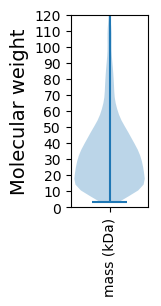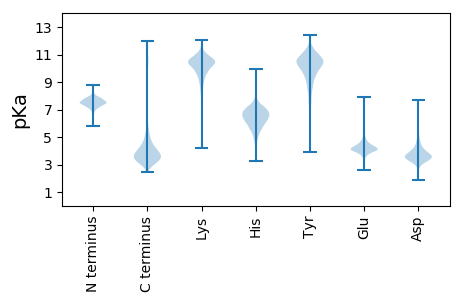
Sphingomonas sp. AP4-R1
Taxonomy: cellular organisms; Bacteria; Proteobacteria; Alphaproteobacteria; Sphingomonadales; Sphingomonadaceae; Sphingomonas; unclassified Sphingomonas
Average proteome isoelectric point is 6.71
Get precalculated fractions of proteins

Virtual 2D-PAGE plot for 4605 proteins (isoelectric point calculated using IPC2_protein)
Get csv file with sequences according to given criteria:
* You can choose from 21 different methods for calculating isoelectric point
Summary statistics related to proteome-wise predictions



Protein with the lowest isoelectric point:
>tr|A0A6M5J7J9|A0A6M5J7J9_9SPHN Ribosomal RNA small subunit methyltransferase E OS=Sphingomonas sp. AP4-R1 OX=2735134 GN=HL653_01760 PE=3 SV=1
MM1 pKa = 6.97KK2 pKa = 9.85TIFAAALAALALGTSAGAAVTYY24 pKa = 10.19HH25 pKa = 5.0VTVDD29 pKa = 3.31TSSQIGKK36 pKa = 9.82AGYY39 pKa = 9.75IDD41 pKa = 4.04LQFGAGCLGGGCNPQLATALVSGFTTDD68 pKa = 3.1GTLQPFDD75 pKa = 4.78GNDD78 pKa = 3.62PNDD81 pKa = 3.83LAEE84 pKa = 4.65GTTGTLPTGVSFDD97 pKa = 3.7NQTFTPSDD105 pKa = 4.04FSQAIIFGSSLSFAVTLSGPAIEE128 pKa = 5.56SPLNDD133 pKa = 3.24GGNYY137 pKa = 9.96VGTAFLFDD145 pKa = 4.45FGNADD150 pKa = 3.09FSDD153 pKa = 4.99FYY155 pKa = 11.23FSQNDD160 pKa = 3.66GGPFGFLAGALHH172 pKa = 6.42IQQDD176 pKa = 3.79GSVLVVANPSSQDD189 pKa = 3.4YY190 pKa = 7.97TQSSGLSFTTITAASDD206 pKa = 3.8VPEE209 pKa = 4.35PASWAMMLAGFGLVGGTMRR228 pKa = 11.84RR229 pKa = 11.84RR230 pKa = 11.84KK231 pKa = 8.97LTVSFAA237 pKa = 3.78
MM1 pKa = 6.97KK2 pKa = 9.85TIFAAALAALALGTSAGAAVTYY24 pKa = 10.19HH25 pKa = 5.0VTVDD29 pKa = 3.31TSSQIGKK36 pKa = 9.82AGYY39 pKa = 9.75IDD41 pKa = 4.04LQFGAGCLGGGCNPQLATALVSGFTTDD68 pKa = 3.1GTLQPFDD75 pKa = 4.78GNDD78 pKa = 3.62PNDD81 pKa = 3.83LAEE84 pKa = 4.65GTTGTLPTGVSFDD97 pKa = 3.7NQTFTPSDD105 pKa = 4.04FSQAIIFGSSLSFAVTLSGPAIEE128 pKa = 5.56SPLNDD133 pKa = 3.24GGNYY137 pKa = 9.96VGTAFLFDD145 pKa = 4.45FGNADD150 pKa = 3.09FSDD153 pKa = 4.99FYY155 pKa = 11.23FSQNDD160 pKa = 3.66GGPFGFLAGALHH172 pKa = 6.42IQQDD176 pKa = 3.79GSVLVVANPSSQDD189 pKa = 3.4YY190 pKa = 7.97TQSSGLSFTTITAASDD206 pKa = 3.8VPEE209 pKa = 4.35PASWAMMLAGFGLVGGTMRR228 pKa = 11.84RR229 pKa = 11.84RR230 pKa = 11.84KK231 pKa = 8.97LTVSFAA237 pKa = 3.78
Molecular weight: 24.21 kDa
Isoelectric point according different methods:
Protein with the highest isoelectric point:
>tr|A0A6M5JJ19|A0A6M5JJ19_9SPHN TonB-dependent receptor OS=Sphingomonas sp. AP4-R1 OX=2735134 GN=HL653_13560 PE=3 SV=1
MM1 pKa = 7.45KK2 pKa = 9.61RR3 pKa = 11.84TFQPSNLVRR12 pKa = 11.84KK13 pKa = 8.96RR14 pKa = 11.84RR15 pKa = 11.84HH16 pKa = 4.61GFRR19 pKa = 11.84SRR21 pKa = 11.84SATPGGRR28 pKa = 11.84KK29 pKa = 9.04VLAARR34 pKa = 11.84RR35 pKa = 11.84ARR37 pKa = 11.84GRR39 pKa = 11.84SKK41 pKa = 11.12LSAA44 pKa = 3.81
MM1 pKa = 7.45KK2 pKa = 9.61RR3 pKa = 11.84TFQPSNLVRR12 pKa = 11.84KK13 pKa = 8.96RR14 pKa = 11.84RR15 pKa = 11.84HH16 pKa = 4.61GFRR19 pKa = 11.84SRR21 pKa = 11.84SATPGGRR28 pKa = 11.84KK29 pKa = 9.04VLAARR34 pKa = 11.84RR35 pKa = 11.84ARR37 pKa = 11.84GRR39 pKa = 11.84SKK41 pKa = 11.12LSAA44 pKa = 3.81
Molecular weight: 5.01 kDa
Isoelectric point according different methods:
Peptides (in silico digests for buttom-up proteomics)
Below you can find in silico digests of the whole proteome with Trypsin, Chymotrypsin, Trypsin+LysC, LysN, ArgC proteases suitable for different mass spec machines.| Try ESI |
 |
|---|
| ChTry ESI |
 |
|---|
| ArgC ESI |
 |
|---|
| LysN ESI |
 |
|---|
| TryLysC ESI |
 |
|---|
| Try MALDI |
 |
|---|
| ChTry MALDI |
 |
|---|
| ArgC MALDI |
 |
|---|
| LysN MALDI |
 |
|---|
| TryLysC MALDI |
 |
|---|
| Try LTQ |
 |
|---|
| ChTry LTQ |
 |
|---|
| ArgC LTQ |
 |
|---|
| LysN LTQ |
 |
|---|
| TryLysC LTQ |
 |
|---|
| Try MSlow |
 |
|---|
| ChTry MSlow |
 |
|---|
| ArgC MSlow |
 |
|---|
| LysN MSlow |
 |
|---|
| TryLysC MSlow |
 |
|---|
| Try MShigh |
 |
|---|
| ChTry MShigh |
 |
|---|
| ArgC MShigh |
 |
|---|
| LysN MShigh |
 |
|---|
| TryLysC MShigh |
 |
|---|
General Statistics
Number of major isoforms |
Number of additional isoforms |
Number of all proteins |
Number of amino acids |
Min. Seq. Length |
Max. Seq. Length |
Avg. Seq. Length |
Avg. Mol. Weight |
|---|---|---|---|---|---|---|---|
0 |
1512193 |
29 |
3870 |
328.4 |
35.33 |
Amino acid frequency
Ala |
Cys |
Asp |
Glu |
Phe |
Gly |
His |
Ile |
Lys |
Leu |
|---|---|---|---|---|---|---|---|---|---|
13.587 ± 0.058 | 0.714 ± 0.01 |
5.864 ± 0.029 | 5.039 ± 0.035 |
3.468 ± 0.026 | 9.069 ± 0.049 |
1.97 ± 0.019 | 5.113 ± 0.026 |
2.826 ± 0.031 | 9.882 ± 0.042 |
Met |
Asn |
Gln |
Pro |
Arg |
Ser |
Thr |
Val |
Trp |
Tyr |
|---|---|---|---|---|---|---|---|---|---|
2.306 ± 0.02 | 2.462 ± 0.029 |
5.486 ± 0.031 | 3.022 ± 0.019 |
7.41 ± 0.044 | 5.406 ± 0.03 |
5.61 ± 0.044 | 7.134 ± 0.027 |
1.404 ± 0.016 | 2.231 ± 0.023 |
Most of the basic statistics you can see at this page can be downloaded from this CSV file
Proteome-pI is available under Creative Commons Attribution-NoDerivs license, for more details see here
| Reference: Kozlowski LP. Proteome-pI 2.0: Proteome Isoelectric Point Database Update. Nucleic Acids Res. 2021, doi: 10.1093/nar/gkab944 | Contact: Lukasz P. Kozlowski |
